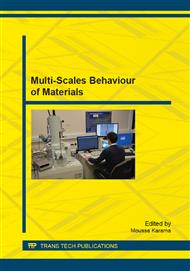p.124
p.130
p.137
p.147
p.160
p.170
p.185
p.197
p.213
Residual Stresses in a Ceramic-Metal Composite
Abstract:
The work of this study concerns the fine modelling of the thermomechanical and metallurgical behavior of interface ceramic-metal in order to determine the residual mechanical state of the structures during brazing process. For these cases, difficulties mainly arise in the modelling of the solid-solid phase transformations as well as in the modelling of the mechanical behavior of the multiphasic material. Within an original theoretical framework - generalized standard materials with internal constraints – we proposed models for the behavior of multiphasic material. The design of joints in engineering structures and the optimisation of the industrial brazing process require determining and analysing such a phenomenon. In this way, the present work aims at predicting the thermally induced stresses (localisation and level) through numerical simulations and then, at defining the main parameters which influence their development
Info:
Periodical:
Pages:
185-196
Citation:
Online since:
December 2011
Authors:
Price:
Сopyright:
© 2012 Trans Tech Publications Ltd. All Rights Reserved
Share:
Citation:


